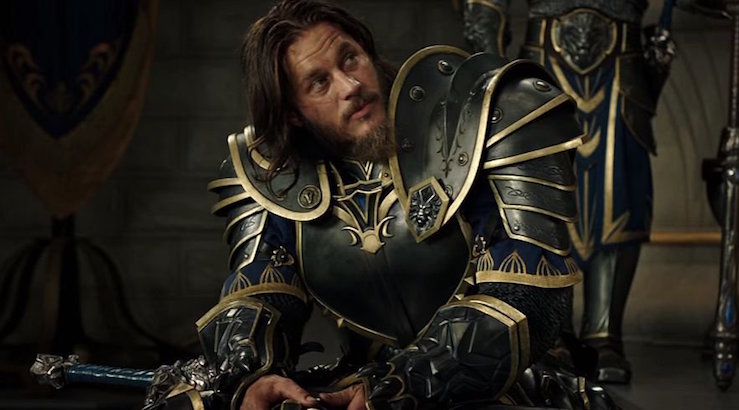So let’s get this out of the way: Remember those parts of a video game where gameplay pauses and you can’t just skip through the cut scene that follows? You know the ones; the game makers spent a lot of time and money making that scene, and by the CG gods they’re going to make you watch every high-resolution second of it.
That’s pretty much what the Warcraft movie is. For two hours.
And you know what? For what it is, as popcorn fare, it was fantasy fun with a wee dose of unexpected emotional connections. (Unexpected, that is, if I didn’t know going in that the film was directed and co-written by Duncan Jones, known to me for his brilliant Moon.) But this isn’t a movie review. Alasdair Stuart already gave you one of those.
This is, instead, the account of what happens when a medievalist watches a quasi-medieval movie.
I fully realize, of course, that the kingdom of Azeroth, where almost the entirety of this film occurs, is not on our earth and that as a result the film can hardly be held accountable to our Middle Ages in any historical way. It is, like George R. R. Martin’s A Song of Ice and Fire (and HBO’s connected Game of Thrones), more properly filed under the general heading “medievalism,” where the imagery and characteristics of the Middle Ages are spun into some new thing. So to look at Warcraft (or anything like it) with an academic eye is perhaps a bit unfair if not simply wrong …
… and yet it is a simple truth that films like Warcraft directly influence our popular conceptions of the historical Middle Ages. Whether it is appropriate or not, whether it is intended or not, whether medieval professors like me like it or not, Warcraft the movie (like Warcraft the video game) is teaching my future students a way of imagining what the Middle Ages are like.
Viewed through that lens, some of the imaginative lessons that Warcraft imparts raised my medieval eye. Like, for instance, the fact that …
Helmets Are Optional.
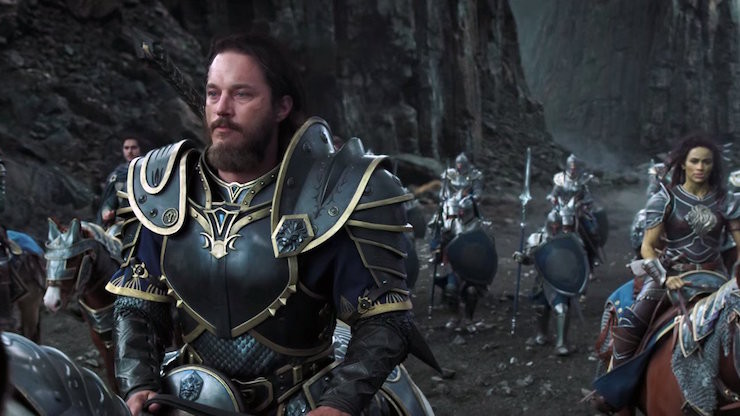
At least for anyone important, they seem to be. In fact, I’d say that having a helmet in this movie is rather like wearing a redshirt on a Star Trek away team. Yes, the king does wear one for a time, but he takes it off as soon as camera-convenient. And there were any number of scenes in this movie where veteran warriors would stride into battle, swathed in plate armor like medieval versions of Iron Man (Go #TeamCap, btw) … but without helmets.
Not like these folks lost their helmets in an earlier fight and were bravely pressing on anyway. More like they’d just never bothered to bring one.
I understand that the filmmakers probably paid a lot of money to get Vikings‘ Travis Fimmel to play Ragnar Lothbrok … er, I mean, Sir Anduin Lothar (nee of the Hill People, perhaps). And, as such, they want the audience to see his pretty face, which is rather more difficult to do if he’s in a helm.
I get that. I understand that. It’s just that, well, it makes some of these gentlemen seem like idiots. And it’s especially strange to the eye given the fact that …
Everyone Wears Plate.
Okay, the Mage doesn’t. And half the time, neither does Garona (Paula Patton), the sultry half-Orc whose green skin and skimpy, battle-beachwear outfits are nicely targeted at the Captain Kirks of the world.
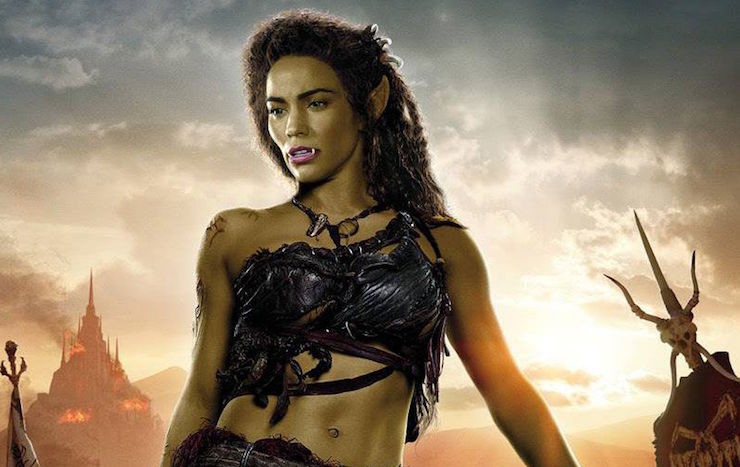
But when it comes to the warrior legions of Azeroth, plate armor is apparently the only way to go.
For a few minutes of screen time I was pondering what this proliferation of plate might say about the economic prosperity of Azeroth — plate is rather expensive to make, and it also requires an extensive expertise in metallurgy and metal crafting — but then an Orc wearing a stylish vest wrought from the twin spines of some exotic beast grabbed hold of a helpless plate-clad warrior and pimple-popped his noggin.
Which only reminded me how useful helmets might be. Except that, as I said, they hide faces the filmmakers would like to see.
The thing is, a lack of helmets occurs quite often in medieval-ish movies, but it just seems far more pronounced when everyone is wearing plate. Aragorn running amok without a helmet is odd, too — after all, as even a ten-year-old bike-rider knows, the one piece of armor you should try to have is head protection — but he’s also not running around in shiny steel plates like a mini-tank.
And of course I say “steel,” but despite the accordant sound effects of it not a lick of anything we see in armor is really steel. The way the men move is entirely unencumbered by weight or plate jointing, very much unlike the reality.
Another separation between this medieval fantasy and medieval reality is the fact that in Azeroth …
Hairstylists Abound.
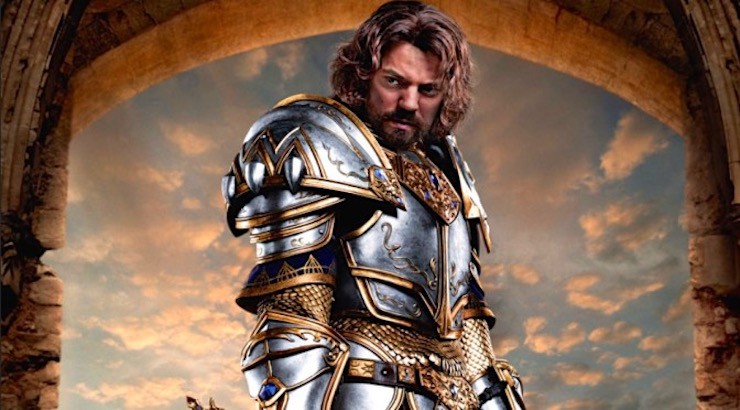
I mean, they must. Pretty much everyone has their hair just so.
None better than King Llane Wrynn (played by Dominic Cooper), though, which I suppose reflects a kind of class reality. It might be taken a bit too far, though: between his chintzy crown and his jaunty hair, the king is straight outta Galavant. A part of me kept waiting for him to burst into song.
At one point, as the king was on horseback riding out of town at the head of his army, he stopped at a viewing stand to say goodbye to his perfectly coifed family amid the crowds of a perfectly coifed nation. He said a few words. He smiled. And I swear he was thisclose to giving us a fabulous Fabio hair flip. It was a near thing, and I’m a little disappointed it didn’t happen, mostly because of the fact that …
Warcraft Doesn’t Care.
Look, there are so very many things that are wrong about this movie in respect to history — whether that’s even a fair lens to use, as I said above — but in the end I don’t think it really matters much, because every time I wanted to roll my eyes at this movie, it rolled its eyes at itself.
I’m reasonably confident, for instance, that when that fellow got his helmless head smashed, Duncan Jones might well have been winking at us.
And in my favorite example, I was just starting to jot down a note about how all the important people have strong legs when the movie brilliantly undercut my realist trolling. From the get-go, you see, Warcraft falls into that mythic and very un-medieval concept of castles and churches that consistently soar to the sky. They look cool, of course, but they aren’t exactly in line with medieval architectural building practices. The bigger worry, though, is that it seemed that in every case the Important People of Azeroth live in its tallest towers.
I call this the Princess Problem. Sure, there’s a nice view way up there. Sure, it’s a bit farther from the stink of the city. And, sure, from there you’re the one sitting atop the privy pipe (look for it on every castle tour!). But it’s also frigid cold atop the tower, and being atop the pipe means you get all those fun smells gassing through your bedroom. Worse still, to go anywhere or do anything you needed to climb up and down stairs. Hundreds of them. Looking at the architecture of Azeroth, in some cases it might be thousands.
The Important People, I’m telling you, must have nice legs. Goes with the hair, I guess.
But just as these academic thoughts came to my mind, just as I started to roll my eyes at another king/wizard/princess in another high tower in another quasi-medieval movie … Warcraft gave me Sir Anduin Lothar, strong warrior hero of the film, panting in exhaustion as he climbed a seemingly endless set of stairs.
“Check-mate, Warcraft,” I wrote in my notes.
And then I sat back to enjoy this oddly entertaining mix of video game violence, casual humor, emotive orcs, and Warcraft Easter eggs.
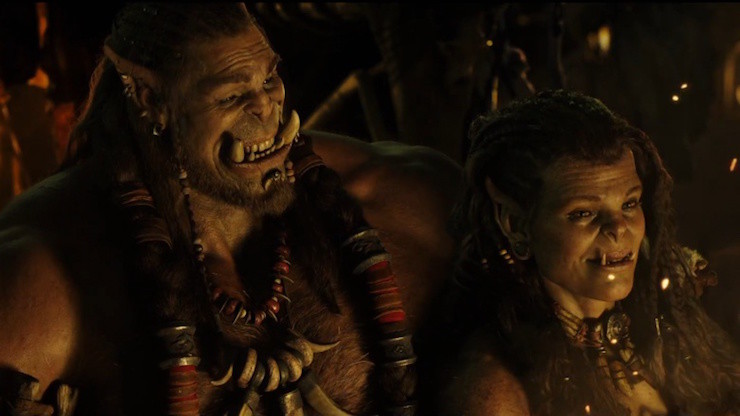
Conclusions
You know, I said at the start that this wasn’t a movie review, but I’m going to give it some ratings anyway:
Accuracy to Source: 9/10 wee-headed Orcs from Warcraft III.
Accuracy to History: 2/10 Sutton Hoo helmets.
Obligatory Library Shots: 7/10 leather-bound codices.
Just Plain Fun: 8/10 over-buttered popcorn bags.
 Michael Livingston is a Professor of Medieval Literature at The Citadel who has written extensively both on medieval history and on modern medievalism. The Gates of Hell, the follow-up to The Shards of Heaven, his historical fantasy series set in Ancient Rome, comes out this fall from Tor Books.
Michael Livingston is a Professor of Medieval Literature at The Citadel who has written extensively both on medieval history and on modern medievalism. The Gates of Hell, the follow-up to The Shards of Heaven, his historical fantasy series set in Ancient Rome, comes out this fall from Tor Books.










